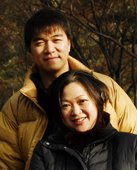Pu Er can be categorized into two main types:
Sheng (also known as Raw, Uncooked and Green Pu Er)
Shu (also known as Ripe, Cooked and Black Pu Er)
Both Pu Er types are made from the same material (Yunnan Big-Leaf) and go through the same fundamental processes during production 鲜采茶叶 > 杀青 > 揉捻 > 晒青干燥 > 晒青毛茶. Production of Shu Pu Er involves some extra steps.
Processes involved in production of Sheng and Shu Pu Er
1. Big tea leaves are picked from trees in the Yunnan region.
2. The enzyme in the raw leaves are deactivated through a process known as "Sha Qing" (killing the greens).
3. The leaves are then rolled - a process called "Rou Nie".
4. Next is to dry the leaves under the sun "Shai QIng".
5. For the processing of raw (SHENG) pu-er tea, it will then be steamed and press into the required shape "Zheng Ya Zuo Qing".
6. For the processing of cooked (SHU) pu-er tea, the sun dried leaves will be further post fremented via "Qiao Shui Wo Tui" then air dried "Feng Gan Xiao Hua" and finally only steamed and pressed to the required shape.
The additional steps introduced in the production of Shu Pu Er are meant to accelerate the aging process in order to imitate the highly desired flavor and appearance of aged Sheng Pu’er. This technique was first tested by Kunming Tea Factory before being perfected by Menghai Tea Industry in the 70s. Shu Pu Er was created because there was an over-demand for Pu Er tea at that time.
Newly produced and un-aged Sheng Pu Er, while drinkable, can be very astringent and requires several years of aging in order for its flavour and texture to be be improved. Thus, Shu Pu Er was introduced as an instantly ready-for-drinking alternative.
Sheng Pu Er Tea tend to consists of light yellowish and greenish buds while Shu Pu Er Tea are basically darker and more reddish in colour.
In addition to these two main types of Pu Er, there is also a lesser known type called “half-cooked”. This is actually made using a mixture of Sheng and Shu Pu Er tea leaves with the intention of creating a tea that is immediately drinkable, but also partly preserving the ability of the tea to age naturally. - Adapted from royalpuer.com




No comments:
Post a Comment